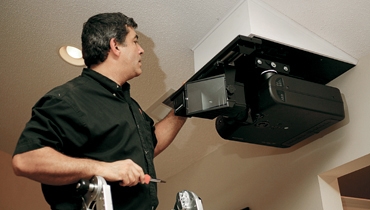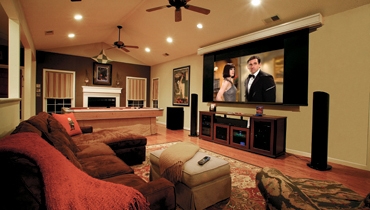My DIY Home Theater Makeover Page 2
With the plasma selected, I knew I needed a projector that would hold its own. I was super-impressed by Marantz's VP-11S2 when it was unveiled at the Consumer Electronics Show. With its handpicked lens and Texas Instruments' Dark Chip 4, it produced blacks nearly on par with the Pioneer. Marantz also unveiled a much more affordable anamorphic lens system at the 2008 CEDIA Expo that mated perfectly with the projector. But I had my first "What have I done?" moment when I unboxed the lens and connected it to the projector. Even though I'd seen these systems many times before, actually having it in my house and knowing that it would be hanging from my ceiling was a little overwhelming. Anamorphic is super cool, and definitely the ultimate in home theater, but sleek and elegant it's not.

Installing the projector meant raising my ceiling fans about 18 inches so that the blades would be out of the light path. This was pretty easily accomplished with a simple pipe cutter. Also, since my ceiling is angled, we needed to fabricate something for the projector and lens system to mount to. I made a template of the roof angle, and Tom built a box that fit perfectly and that gave the projector mount a less "industrial" look.
I was concerned that the length of the cable run from the projector to the preamp -- about 40 feet -- would cause HDMI to have resolution and dropout issues. But I talked to Monster Cable, and the company assured me that its M1000HD cable would reliably send 1080p signals that far. We also ran Romex power cabling and two runs of Cat5 for control from the projector straight to my equipment rack.
I don't like to be distracted by empty, white screen, so I wanted to have masking for when I watch anything shot in a 16:9 aspect ratio. But not many manufacturers offer 2.35:1 screens with motorized masks for converting to 16:9. I went with Draper's Access MultiView because it had exactly what I wanted at a price that didn't blow my budget. The tab tensioning also keeps the screen nice and flat, even when it's been rolled up for a while. I have independent IR control over both the screen and the masking so that a macro on my remote control called Anamorphic raises the masking, puts the projector into vertical-stretch mode, and engages the lens system. Seeing this happen for the first time brought squeals of joy heretofore unknown in our home!

Selecting the screen size was a little tricky. I knew that I wanted it to be significantly more impressive than the 60-inch plasma, and in my 11 years as an installer I've never had a customer tell me they wish they'd gone smaller. But the screen couldn't be so huge from our seating distance of roughly 12 feet away that it wouldn't be enjoyable to watch. Originally, I wanted a 100-inch 16:9 image, but that would have produced a 125-inch diagonal 2.35:1 image, which was just going to be too big. I opted for 92-inch 16:9, which produced a 2.35:1 size of 115 inches.
When the box for the screen arrived -- all 13 feet of it! -- I had my second "Dear God! What have I done?" moment. But once we got it on the wall, it was definitely the right choice. And even though the case is designed to mount in an attic -- impossible because of the way my trusses run -- its all-white exterior doesn't draw too much attention to itself.




























































